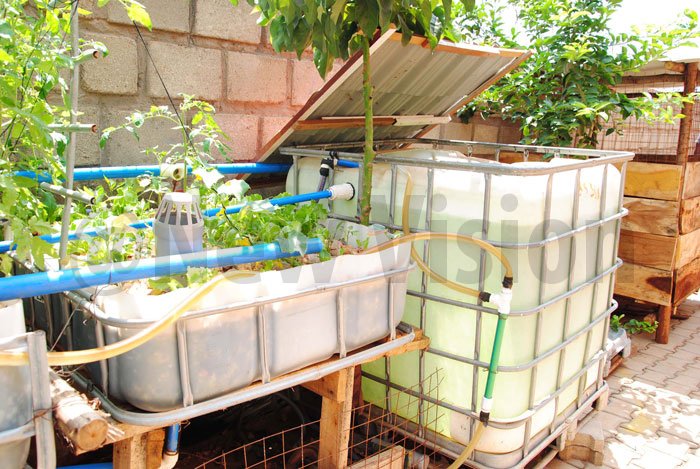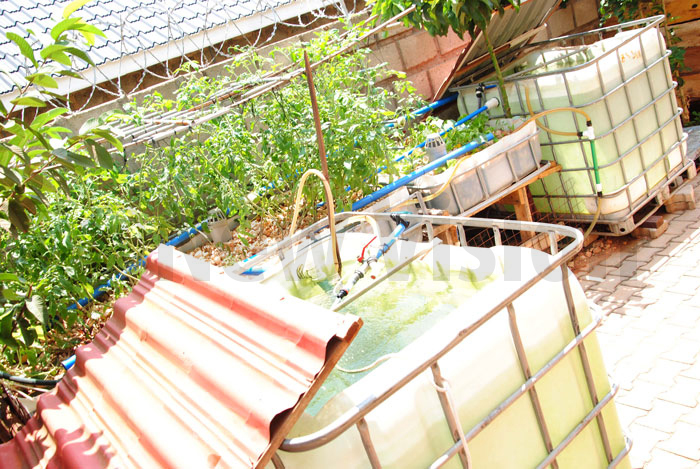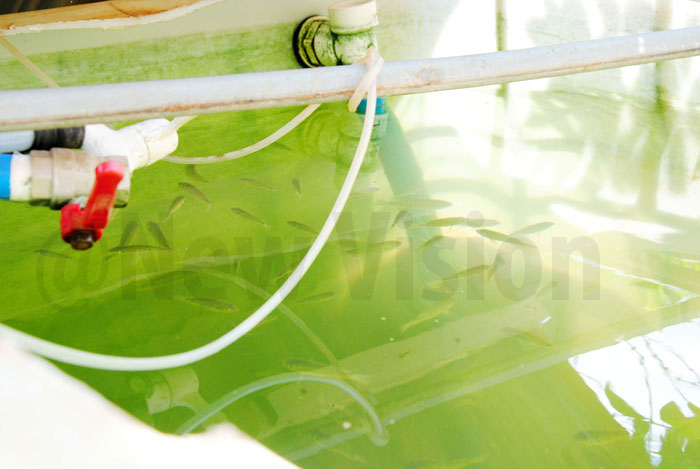Go fishing in your backyard
The fish are expected to mature between six to eight months. Currently they are three months. Although Ntende has two fish tanks, he says one can use less or more tanks. The system can also be integrated with soil based agriculture.
What do you do when the price of your favourite healthy meal soars, and you have to fork out more and more money? You grow it, eat it and sell the surplus to your neighbours!
34-year-old John Ntende, an engineer by profession and manager corporate planning with Electricity Regulatory Authority, did just that. The father of one was inspired to start a fish farm right in his paved back yard.
"My inspiration was the cost of the fish. I have fish on a weekly basis but the fish prices would keep increasing. And the hygiene in those fish markets is terrible. So I went online and researched on how to grow fish on a small scale without using a pond or cages," the soft spoken engineer says.
The words, fish farming, may conjure up images of gigantic fish cages or ponds, but that is not so in this type of fish farming, technically referred to as aquaponics. It can sit on an area as small as 10 by 10 ft, about the size of an average bedroom!
The engineer describes aquaponics as the combination of aquaculture (raising fish) and hydroponics (the soil-less growing of plants) that grows fish and plants together in one integrated system.

The innovation
After lots of research online, Ntende knew exactly what he wanted to set up. However, apart from the water pump, Ntende did not import the materials he used to set up the system. The innovator in him went to work. He improvised the different parts and after a few weeks, his aquaponics system was ready for use.
How aquaponics works
He raises the fish in two 1,000 liter water tanks. Each tank is stocked with 70 fish, though 100 is the maximum. Between the tanks are three grow-beds. A grow bed is any container filled with a growing media. Ntende uses the bases of three 1000 liter water tanks as grow beds. They are filled with a layer of rocks, instead of soil, where he sprinkled vegetable seeds. Growing there are vegetables, such as cucumber, tomatoes, beetroot and spinach among others.
"The fish and the plants are in a symbiotic relationship. After I have fed the fish in the water tank, the water gets dirty because the fish release waste in form of ammonia. Through a pipe, that dirty water is directed to the grow beds. The rocks have nitrifying bacteria, which breaks down the ammonia into nitrates which are good for the plants' growth," he explains.
With the ammonia gone, the water is clean and is then directed through a pipe to a water tank below the grow beds. Inside that water tank is a small water-proof water pump, which pumps the water back to the fish tanks, and the cycle continues.
He also improvised covers on the fish tanks. They are made from a bit of wood and Iron sheets.
"These keep the birds from eating the fish and also block the sunlight from getting into the tanks as it would cause algae to grow. That takes away the oxygen from the fish," he explains.
The fish are expected to mature between six to eight months. Currently they are three months. Although Ntende has two fish tanks, he says one can use less or more tanks. The system can also be integrated with soil based agriculture.
"You can have a small soil based garden somewhere and use the water from the fish tanks to water the plants," he says.

He expects the fish to weigh at least 500gms on maturing. Ntende's fish will mature around the same time. But he advises, that in cases where one has more than one fish tank, the ages of the fish should not be uniform across the tanks. That way, the fish mature at different times.
"For example if the farmer is selling the surplus, they will be able to avail fish for their clients over a long period of time," he explains.
Costs
Ntende says the system cost him less than shs2.5m. "In six months the fish will be mature and selling each at about sh3m means you will have the initial sh2.5m costs back," he says.
All the materials Ntende used are available locally in hard ware shops, save for the water pump he ordered online from China. It cost between sh300,000 and sh500,000.
"Electricity for running pump 24hours a week approximately costs me sh30,000 a month," he says.
In case of a power outage, he runs water from the tap and it slowly drips by gravity into the fish tanks.
However, he says he plans to install solar system within in the future, because it's more reliable in comparison to paid the power.
He continues that the water costs are low because the water is simply recycled. However, weekly, he tops it up with 20 liters to make up for the evaporation. The system is connected to a tap through a hose pipe.
To increase the amount of oxygen in the water, he places a small air pump slightly underneath the water surface of the fish tank, which he says goes for about sh100,000.
He bought the 170 fish from a farm in Matugga, and they cost about sh350 each. The rocks in the grow bed can be accessed at places with building materials. Each small truck of rocks is about sh150,000.

Purely organic, no chemical sprays
There are no chemical sprays used, it's purely organic. For starters, due to the absence of soil, soil based diseases and pests are not likely to attack this system. But in the event that they do, organic sprays are advised.
"You are not supposed to use any kind of chemical because the fish will die. However, you can use organic based chemicals, these you can even make yourself by crushing, for example garlic sprays, lemon sprays, and ginger sprays," he says.
He further explains that if chemical sprays are applied, the bacteria that turn the ammonia into nitrates for the plants to consume will die. Hence, the water won't be cleaned and when it flows back to the fish, they will die from toxicity.
"The whole system is totally natural. So you can sell the fish and the vegetables fresh from the garden without any chemicals which cause cancer," he notes.
Feeding
"Because this is a small project, I make my own feeds," he says.
He makes a paste from crushing silver fish, maize brand and greens. The greens are to provide the minerals and vitamins, after which he puts the paste in a nozzle bottle. He squeezes the paste out in fine lines on a flat surface to sun dry.
"When they harden, I break them into bits by hand, and they are ready for feeding the fish," he says.
The fish are fed a handful, thrice a day but the portions increase as they grow older.
"I sprinkle the feed onto the water and watch as they eat. If the feeds are consumed within 10minutes, then I know I have given the right quantity. And if after 10 to 15minutes there is left over food floating, then I need to reduce on the portions. If all the feeds are consumed before 10minutes elapse, then I am under feeding them and need to increase the portions," he explains.
You can do this!
Putting up the system is a Do It Yourself, though one may need to hire some skilled labour along the way, for example a plumber to install the plumbing system and electrician to do the wiring.
"This is something that can be done by everyone. I was not trained in biology, agriculture or anything. It's just research on the internet," he says.
International picture
Ntende says that he learnt from research that many Americans are practicing aquaponics because there is a movement towards organic farming.
"Commercial farmers are using an assortment of chemical sprays, which many consumers are uncomfortable with, hence turning to aquaponics, a purely organic process," he explains.
"It's not unusual to find aquaponics on apartment rooftops and backyards," he says.
He adds that it's also common in countries which don't have water like Saudi Arabia, Egypt and Qatar among others. In Africa though, not so many have embraced it.
Uganda and the dwindling fish
Uganda s fish exports have declined and according to research by the Uganda Fish Processors and Exporters Association (UFPEA) as a result of illegal fishing. Consequently, many suppliers who buy the fish from the fishermen that get the fish from the lake which is depleted have closed shop. Only eight out 21 factories are in operation, but still operating at 20 to 30 percent below capacity because there is no fish.
In 2005, Uganda was exporting about 36,000 tonnes worth shs486billion but by 2014 the volumes had declined to 14,000 tonnes valued at shs299 billion. Hence aqua culture needs support from the government.
Dr Edward Mwanja, a fish specialist breeder at National Fisheries Resources Research Institute (NaFIRI), said Aquaculture was identified as the best way forward because lakes are not expanding," Mwanja says.
Fish now accounts for almost 17% of the global population's intake of protein, a report from Food and Agricultural organisation says. FAO estimates that fisheries and aquaculture support the livelihoods of 10-12% of the world's population.
According to the report, aquaculture contributes up to 44.1% of world fish production. The report said all continents have shown a general trend of an increasing share of aquaculture production in total fish production, due to increasing challenges in capture fisheries (fishing on lakes, rivers), including climate change.